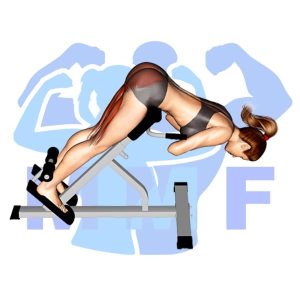Are you feeling frustrated with traditional crunches or sit-ups? Do you feel a strain in your neck or back when performing them? It’s a common issue that people face. We often forget that the primary focus of these movements should be our abdominal muscles, and instead, we place unnecessary tension on our neck and lower back. However, don’t beat yourself up about it! Luckily, there are alternatives to traditional crunches that can help alleviate discomfort while still targeting the core muscles. The solution to your problem may be as simple as swapping out regular crunches for the knees up crunch. In this blog post, we’ll dive into what the knees up crunch is, how to perform it correctly, and the benefits you can reap from incorporating it into your routine.
Knees Up Crunch Summary
- Primary Muscles: Rectus Abdominis
- Secondary Muscles: Obliques
- Equipment: Body Weight
- Mechanics Type: Isolated
- Force: Pull
- Utility: Auxiliary

Knees Up Crunch Instructions
- Start off by lying on your back, knees bent, and back flat.
- Now raise your knees up to your chest, pulling with your core.
- Then lower your feet back to the ground.
- Continue the Knees Up Crunch for a complete set.
Video Tutorial
Knees Up Crunch Muscles
Target (Agonist)
Synergists
Dynamic Stabilizers
- None
Stabilizers
- Deltoid – Anterior
- Pectoralis Major – Clavicular
- Wrist Flexors
Antagonist Stabilizers
- None

Benefits of Knees Up Crunch
The Knees Up Crunch is an effective exercise for strengthening the rectus abdominis muscle. This exercise engages the core and strengthens the abdominal muscles, resulting in increased stability and improved posture. It also works the hip flexors and obliques, which can help with balance and coordination. Additionally, this exercise is great for improving circulation and flexibility. The Knees Up Crunch is a great addition to any strength training or fitness routine, as it provides numerous benefits for the muscles in the abdominal area.
Tips for Performing Knees Up Crunch
You’ve come to the right place if you’re motivated to enhance your knees up crunch performance. These tips can allow you to fully benefit from this first-class workout and make the best of its effects. You’ll have the ability to shape your stomach muscles, and reduce your risk of injury. Let’s begin and take a look at how these tips will help you.
- Start slowly and increase intensity gradually: When beginning Knees Up Crunch, start with a lower intensity to get your body used to the movements and the strain it will be put through. As you become more comfortable, you can increase the intensity of the exercise for greater results.
- Maintain proper form: It is important to maintain proper form while doing Knees Up Crunch in order to get the most out of the exercise and avoid any injuries. Keeping your back straight and your core tight will ensure that you are getting the full benefit of the exercise.
- Take breaks when necessary: Knees Up Crunch can be intense and it is important to take breaks when you need them. Taking regular breaks will help to prevent overtraining, which can lead to fatigue and injuries.
Benefits and Tips Video
Frequent Mistakes To Avoid
Staying away from errors can mean the distinction between a productive training session and an injury when performing knees up crunch. From bad form to not keeping your core engaged, these errors can reduce the productiveness of the exercise and can even increase your risk for injury. But relax, it’s not as challenging as it might seem. By knowing the errors to avert and taking the appropriate actions, you can execute the exercise safely and effectively. So let’s get started on avoiding those typical mistakes and making this exercise a normal part of your fitness training.
- Not engaging their core muscles: Not engaging the core muscles during the exercise will reduce its effectiveness, as the core is what helps to stabilize the body and create a strong foundation for the movement.
- Not keeping the neck in line with the spine: Keeping the neck in line with the spine is essential to prevent strain on the neck and shoulders. Not doing so can cause pain and discomfort in those areas.
- Moving too quickly: Moving too quickly through the exercise can cause improper form, which can lead to injury and reduce its effectiveness. Taking time to move slowly and mindfully will ensure proper form and maximize results.
Find More Bodyweight Exercises Here
Variations and Complementary Exercises
If you’re looking for some variations, complementary, or alternative exercises to the exercise Knees Up Crunch, there are plenty of great options out there. Here is a list of exercises that work similar muscles as the exercise Knees Up Crunch:
Jack Split Crunch

Jack Split Crunch is an effective and efficient exercise that can be used as a complementary or an alternative to the Knees Up Crunch. This exercise targets the upper abs and works the entire core area. It is performed by lying on your back and bringing your legs up towards your chest while keeping your arms straight in front of you. You then bring your arms up to meet your legs and crunch them together, then lower them back down. This exercise is great for engaging the entire core and strengthening both your upper and lower abdominal muscles. It can be used as an alternative to Knees Up Crunch when looking to strengthen the core muscles.
Jack Plank

Jack Plank is an effective alternative or complementary exercise to the Knees Up Crunch. It is a full-body exercise that targets the core, shoulders, arms, and legs. The Jack Plank involves getting into a push-up position and then bringing one foot off the ground at a time, alternating between left and right. It is important to keep the core tight throughout the exercise, as this will help to engage all of the major muscle groups. The Jack Plank can be modified by keeping the hands on the ground instead of coming up on the toes. This modification can help to make the exercise easier for those who are new to it.
Jack Knife

Jack Knife is an effective complementary or alternative exercise to the Knees Up Crunch. It targets the same muscles as the Knees Up Crunch, but with an added twist. The Jack Knife involves lying on your back and raising your upper body and legs off the ground at the same time. This exercise strengthens the abdominal muscles and obliques while also engaging the core, hip flexors, and quads. It is a great way to challenge yourself and keep your workouts interesting.
Check Out These Top Bodyweight Exercises
Hip Thrust Crunch

The Hip Thrust Crunch is a great complementary or alternative exercise to the Knees Up Crunch. This exercise targets the same abdominal muscles as the Knees Up Crunch, but with the added bonus of engaging the hip flexors and glutes. To perform the Hip Thrust Crunch, start by lying on your back with your feet flat on the ground and knees bent. Then, thrust your hips up towards the ceiling and crunch your upper body towards your legs. Make sure to keep your core engaged throughout the entire movement. This exercise provides an excellent way to increase abdominal strength and stability without placing too much stress on the lower back.
Hip Lift

Hip Lift is a great exercise to complement or act as an alternative to Knees Up Crunch. This exercise works the core and lower body muscles, and can help you to increase strength and flexibility. The Hip Lift exercise requires you to lie on your back, with your legs bent at the knees and your feet flat on the floor. Then, you lift your hips up towards the ceiling, squeezing your glutes, and then lower them back down. This exercise will help to target the core muscles as well as the glutes and hamstrings, providing a full body workout that can help to improve posture and overall strength.
Bridge On Knees

Bridge On Knees is a great complementary or alternative exercise to the Knees Up Crunch. This exercise helps to strengthen and tone your glutes, hamstrings, and core muscles while also engaging your arms. To perform the exercise, start by lying on your back with your feet flat on the floor and your knees bent. Then, raise your hips up off the floor, keeping your legs and feet together. Hold this position for a few seconds before slowly lowering your hips back down. This exercise works all of the same muscle groups as the Knees Up Crunch while also adding in some arm work. It is an effective way to add variety to your workout routine and keep your body guessing.
Find More Abs Exercises Here
Opposing Complementary Exercises
To further complement the exercise Knees Up Crunch, it is important to work the opposing muscles. This helps to create balance and strength throughout the body. The following exercises will target the opposing muscle groups and can be done in addition to the Knees Up Crunch:
45 Degree Hyperextension

The 45 Degree Hyperextension is a great complementary exercise to the Knees Up Crunch. This exercise works the lower back muscles, which are the opposing muscle group to the abdominals targeted with the Knees Up Crunch. The 45 Degree Hyperextension helps to strengthen and develop the lower back muscles, which can help improve posture and reduce back pain. It also works the glutes, hamstrings, and spinal erectors, adding further benefits to your overall core strength. This exercise can be done with or without weight, making it a great choice for all levels of fitness.
Straight Leg Cable Pull Through

The Straight Leg Cable Pull Through is a great exercise to pair with the Knees Up Crunch. It works the opposing muscle group of the lower body, specifically targeting the glutes, hamstrings, and lower back. By activating these muscle groups, the exercise helps to balance out the abdominals that are targeted in the Knees Up Crunch. With both exercises working opposing muscle groups, they help to create a more balanced and efficient workout.
Bird Dog Plank

Bird Dog Plank is a great complementary exercise to the Knees Up Crunch. It works the opposing muscle group and helps to strengthen the core and improve stability. The Bird Dog Plank requires you to assume a plank position while extending one arm and the opposite leg, alternating sides as you hold the plank. This helps to build a strong foundation in the core while working the obliques, back and glutes. As a result, it helps to balance out the Knees Up Crunch which works the abdominals, hip flexors and lower back. Together, these two exercises can provide a complete core workout for stability, balance and strength.
Crunch Your Way to Stronger Abs
If you’re looking to strengthen your abs and achieve a tighter core, the knees up crunch is a great exercise to include in your routine. Not only does it target your rectus abdominis (the six-pack muscle), but it also engages your lower abs and hip flexors. By lifting your knees and lower legs off the ground, you increase the resistance on your abs and make the exercise more challenging. Keep in mind that proper form and technique are crucial to avoid strain on your neck and lower back.
References: Wikipedia | ExRx.net | PubMed.gov | Comprehensive List of Abs Bodyweight Exercises

